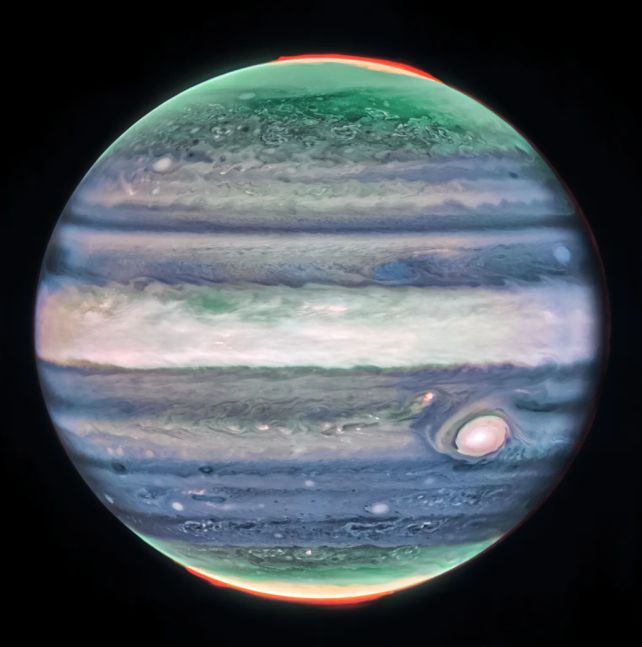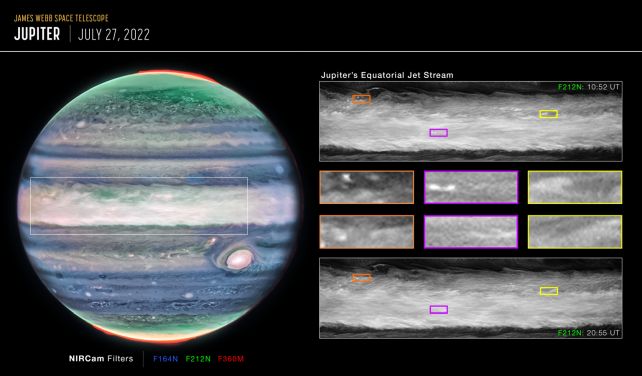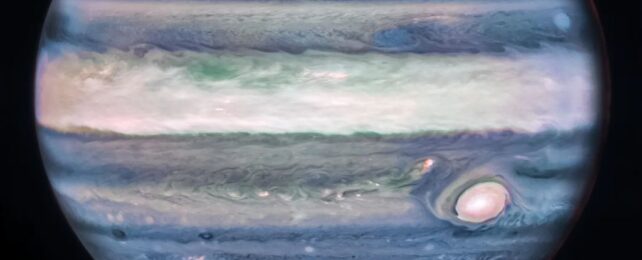Jupiter is the second-largest object in the entire Solar System, with the Sun being the largest. Its greatest distance from Earth is just under 4 astronomical units, and we've sent quite a number of probes to take a closer look at the giant planet's wild atmosphere.
Yet, somehow, we're still only just finding never-before seen features in Jupiter's tempestuous clouds. Scientists have discovered a high-speed jetstream, some 4,800 kilometers (3,000 miles) wide, that hurtles around the planet's equator, above the cloud layer.
This discovery, made using the infrared James Webb Space Telescope (JWST), could give us some new insight into the weird and wacky dynamics of Jovian weather, a system we understand but poorly.
"This is something that totally surprised us," says astronomer Ricardo Hueso of the University of the Basque Country in Spain. "What we have always seen as blurred hazes in Jupiter's atmosphere now appear as crisp features that we can track along with the planet's fast rotation."
Jupiter's atmosphere is certainly a thing of wonder. Its alternating bands of light and dark cloud – known as zones and belts, respectively – are not only whirling around Jupiter at different altitudes, they also travel in opposite directions. And we're not entirely sure why they are the way they are.

When you look at Jupiter in different wavelengths, you can see details that might not appear in optical ranges. You won't know, just looking at it through a telescope, that Jupiter has the most powerful aurorae in the Solar System, for example – because they glow in ultraviolet light.
JWST is the most powerful infrared telescope ever built, and its near-infrared view of Jupiter, released earlier this year, almost looks like a photo negative of the giant planet. These wavelengths are sensitive to upper levels of the Jovian atmosphere, the mysterious region that sits between 25 and 50 kilometers (15 to 30 miles) above the cloud tops.
A close analysis of the images resolved the jetstream, previously only visible as a sort of vague haze. Hueso and his colleagues found that the powerful stream sits at about 40 kilometers (25 miles) above the cloud tops, whipping around Jupiter at a breathtaking speed of 515 kilometers per hour.
This could have very interesting implications for Jupiter's weather patterns, the researchers say. They compared the data from Hubble observations of the lower cloud levels, which travel at half the jetstream's speed. They are, the researchers say, the most precise measurement yet of how Jupiter's equatorial wind speed varies with altitude.

Small-scale storm features that appeared and disappeared between rotations, in combination with the different wind speeds, were consistent with vertical shears. Comparing this to information we have from studying Jupiter, this could mean that the jetstream is part of a weather pattern that we should be able to observe.
"Jupiter has a complicated but repeatable pattern of winds and temperatures in its equatorial stratosphere, high above the winds in the clouds and hazes measured at these wavelengths," says planetary scientist Leigh Fletcher of the University of Leicester in the UK.
"If the strength of this new jet is connected to this oscillating stratospheric pattern, we might expect the jet to vary considerably over the next two to four years – it'll be really exciting to test this theory in the years to come."
The research has been published in Nature Astronomy.
